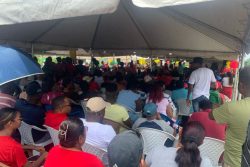Introduction
This will be my last column as a regular writer for these pages. I am acutely aware that the column has not been forthcoming on a weekly basis recently. Hence my desire to relinquish these pages to someone who can give them the time they deserve. I was often asked how I managed to write this column and run my day-to-day business as well. The truth is getting that as my business grows it is becoming more and more difficult. This meant that I was writing the column at anti-social times thereby becoming a strain on my commitments outside of work. The year 2008 will bring more commitments, including professional exams in April. Opportunities have arisen for me to expand my presence in the region. I plan to do so. Nevertheless if time permits I hope to continue my analysis of public company accounts in the Stabroek Business.
A review of the
regional markets
In my analysis of the region’s stock market performance for 2006 I predicted Guyana would be the best performing market in 2007 and Trinidad would be the poorest performer. If it were not for the recent dip in the index, Guyana would have been the top performer for the year. However the ECSE index is up over 40% since the beginning of the year so barring any large price swings on Monday it looks like it will be the best performing market. The data from the graph comes from the various exchanges; I calculate the van Beek Index (vBI) based on data from our local exchange (www.gasci. com). The ECSE does not publish historical data for its index. Guyana is up 37.5 per cent, Barbados is up 12.9% Jamaica is up 6.2% and Trinidad is up 0.3% for the year. All three of the major exchanges started the year with a sell off to various degrees, before recovering to finish in positive territory.
It is interesting to analyse the performance of the Guyana Market by stock. The figures in the following table are based on data provided by GASCI and share price shown is the last trade price.
There have been no stocks declining in value in 2007; all stocks either posted gains or ended the year in line with the last trade price at the beginning of the year (note some stocks did not trade during the year). The stock which posted the biggest gains was Caribbean Container Inc (CCI) with a two-and-a-half fold increase. Given the company has recently managed to restructure its debt it is not surprising to see volatility in the share price as the market prices in the new information. Republic Bank (Guyana) Ltd (RBL) also saw triple digit gains, with a doubling of the share price over the year. Unlike previous growth which was driven by earnings, RBL has seen a significant re-rating by the market: the Price Earnings (PE) ratio has increased by 80% hence the stock is trading at 11.5 times earnings compared with 6.4 a year ago. The market is thus pricing in much greater earnings growth than previously.
Other stocks with significant increases are Demerara Bank Ltd (DBL) and Demerara Tobacco (DTC) up 89% and 54% respectively. Unlike RBL, DBL has seen its PE reduce slightly, hence the increase in share price reflects the growth in earnings. The growth in DTC has largely been down to a re-rating; the PE has grown from 5.9 to 8.5 while earnings have increased 8 per cent. Two other stocks have seen double digit growth, Guyana Bank for Trade and Industry (BTI) is up 20% and Demerara Distillers Ltd (DDL) is up 16 per cent. DDL has seen a slight increase in its PE ratio with the remainder of the share price increase reflecting earnings growth. Perhaps the most interesting case is BTI. Here, despite a 79% increase in earnings the share price has increased just 20% – representing a substantial reduction in rating. The share price now stands at just 5.3 times earnings compared with 7.9 a year ago. It is not clear why BTI should be trading at an earnings multiple of half of its banking peers and, ignoring Citizen’s Bank Inc (CBI) which has not traded in nearly four years, its PE ratio is now the lowest in the market.
To round up, Sterling Products Ltd (SPL) and Banks DIH Ltd (DIH) have seen gains of 9% and 2% respectively. SPL’s PE ratio stands at the highest in the market and the share price growth reflects a further 13% over the 2006 level. DIH has seen earnings growth of 10% so the modest growth is more a reflection of the PE reducing some 8%.
For 2008 I do not have any strong feelings on which markets will under or over perform. Guyana’s market is now trading at higher multiples of earnings than it has seen before, thus I think growth will be constrained to being in line with earnings. I do not expect to see further price increases due to significant increases in PE ratios. Indeed for the stocks now trading at significant multiples of earnings if earnings growth does not materialise, then prices may well fall as lower expected earnings growth is priced in. I would thus expect that Guyana will not be the top performer. Other than that I think any of the other Caribbean markets have potential to be the best performing market in 2008. The ECSE seems to be on somewhat of a bull run, and in Trinidad earnings are finally catching up to prices bid up in 2003-2005.
The writer has an interest in BTI, CBI, DBL, DDL, DIH, DTC, RBL, PHI and SPL by virtue of the writer and/or an associate being a shareholder.






